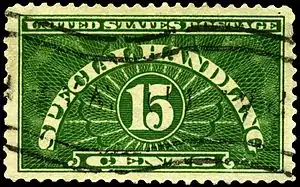
Special handling originated as a service that secured accelerated processing of fourth class mail (mostly parcels), so that it would be delivered as promptly as first-class material. This was to protect perishable items, with specific mention of live animals, from loss in the mails. It was considered a separate service from special delivery.
The United States Post Office Department introduced this service in 1925, and provided a deep green 25¢ Special Handling postage stamp for it. As rates changed, three additional U. S. Special Handling stamps (10¢, 15¢ and 20¢) appeared 1928. Except for the given value, the basic colors and designs of all the Special Handling stamps were identical.
The three latter denominations, as well as a second issue of the 25¢ stamp printed earlier in 1928, appear more yellow-green in tone than the original 1925 issue. In addition, various minor plate variations exist through the series, and the 1940 printings of the three lower values (the 25¢ stamp had been withdrawn late in 1928) are somewhat greener in appearance. However, catalogs normally list only the two 25¢ stamps as having noticeable color varieties.[1] Finally, the three lower denominations were reissued in dry printings in 1955.[2] This led to slight differences in the stamps' gum, paper and design sizes, and specialized catalogs may show them as sub-varieties.
While the stamps were withdrawn in 1959, today (2015) the USPS provides this expedited delivery of packages by other means: through first class parcel service and priority mail. Special handling still exists, but is now more restrictively defined: it "provides preferential handling, but not preferential delivery, to the extent practicable in dispatch and transportation."[3] This service is primarily recommended for the delivery of live poultry, bees and similar cargo versus the delivery of non-living goods. Postal employees will take care to ensure that the special handling package is not crushed or handled roughly during delivery.
References
- ↑ Stamps for Chicks...and Baby Alligators
- ↑ Snee, Charles, ed. (2012). Scott Specialized Catalogue of United States Stamps and Covers 2013. Scott Publishing Co. p. 402. ISBN 0894874756. OCLC 781677423.
- ↑ "Domestic Mail Manual 503 Extra Services:13.0 Special Handling". U. S. Postal Service. Retrieved 2013-12-02.